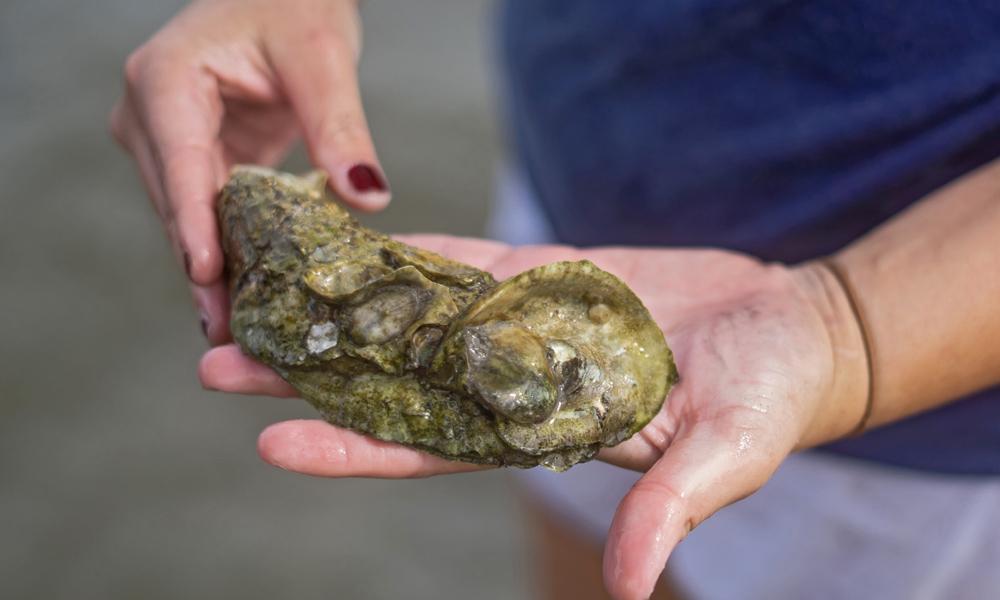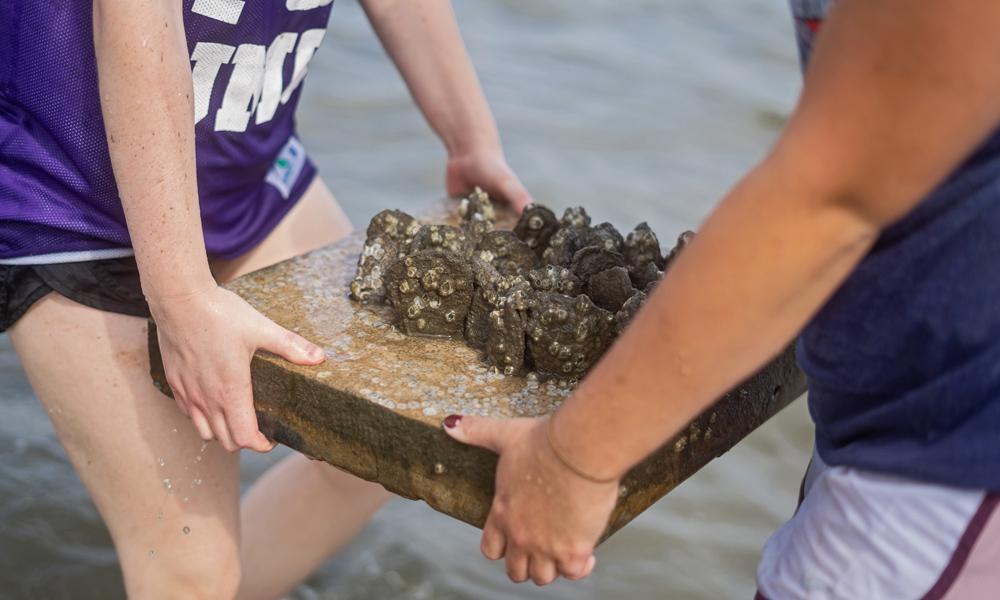Research suggests oysters have a thing about personal space
NewsSUMMARY: With the help of the Madison Trust, graduate student Bailie Lavan and professor Patrice Ludwig ('96, '01M) are designing artificial oyster reefs and studying their potential to help restore oyster colonies and protect the health of the Chesapeake Bay watershed.
By Eric Gorton (’86, ’09M) and Jim Heffernan (’96, ’17M)
A JMU graduate student and her faculty adviser appear to be zeroing in on an improved design for artificial oyster reefs.
Since May 2018, Bailie Lavan has been observing the concrete tiles that she and biology professor Patrice Ludwig ('96, '01M) designed and placed in the Lynnhaven River near Virginia Beach to see if oysters would cling to them, and if they did, if they would grow. Each tile was created using molds in a lab at JMU and features a different amount of space between the concrete shells. The designs were based on observations of natural reefs and the idea that the space between objects is important.
“It looks like our data is leaning toward supporting our hypothesis of there being an optimal amount of space, so that’s fantastic news,” Lavan said.
The oysters are settling on all of the tiles, Ludwig added, but tend to grow best on the ones that have just the right amount of space between them and the artificial shells—the Goldilocks principle.
When oysters reproduce, the larvae swim or float freely in the water until they find a hard substrate to cling to—usually an oyster shell. Once they settle, they remain there for the rest of their lives.
Ludwig said building new oyster reefs is critical for the health of ecosystems like those in the Lynnhaven River and the Chesapeake Bay, which the river flows into.
“There is a huge global oyster decline and if we don’t address it right now, then we are going to see further collapse of ecosystems,” she said. “We’re not going to be able to bring them back.”
 |
| A closer look at one of the oysters making the artificial reefs its new home in the bay. |
While oysters are a common item on seafood menus, they also play a crucial role in nature, filtering impurities out of the water in which they live.
By installing artificial reefs that mimic natural ones, “maybe we can facilitate the growth of these reefs faster,” Ludwig said. “Bailie’s work will inform the long-term designs.”
The designs may be further refined by the results of a separate research project involving 3D photography of natural reefs, which Lavan said is also supporting her spatial hypothesis.
While Lavan plans to graduate with a master’s degree in biology in May, her work has set the stage for future study. Now that the reefs have been installed, undergraduates can spend the summer collecting more census data. “We can build a long-term data set, and long-term data sets in science are extremely valuable,” Ludwig said.
The project received funding from the Madison Trust, JMU’s philanthropic investment competition. Ludwig made the pitch to a group of investors at the inaugural event in November 2014.
|
"There is a huge global oyster decline and if we don’t address it right now, then we are going to see further collapse of ecosystems." — Patrice Ludwig, biology professor ('96, '01M) |
Her passion for restoring oyster reefs in the Chesapeake Bay watershed inspired JMU parents John and Robin Reifsnider to help fund the project.
“Patrice is a winsome soul and a very good presenter,” Robin said. “She really sold us on her mission and what she wanted to do with this. We thought this could really change some things for the better.”
The project has special meaning for Robin, who grew up in Florida along the St. Johns River. “I was always surrounded by bodies of water and have always been particularly concerned with the flora and fauna that they have in them and what you need to do to protect them, and what they, in turn, do to protect you,” she said. “In the case of oyster reefs, they help clean the water. It’s a very reciprocal relationship.”
So naturally, when it came time to deploy the team’s concrete tiles, Robin tagged along to help.
“It was a beautiful day to be out on the river and just so rewarding to see the research and the hard work in the classroom and in the laboratory come together,” she said.
 |
| Researchers and one of the Madison Trust donors work together to deploy the artificial oyster reefs. |
“I love the fact that John and I were able to give money [to the project],” she said, “but to see where it’s actually going and to see the impact that it can potentially have for the homeowners on the river—and ultimately the health of the bay—that was really special.”
Ludwig said it’s rare for a donor to follow researchers out in the field. “Robin was there on one of the most important days of my life, right beside me, putting tiles in the water with my graduate student and my husband.”
As the project has evolved, “Robin has been an ear for me, whether I was frustrated or if something went really well,” Ludwig said. “I felt like I had an open line of communication to her and I could contact her any time.”
The Madison Trust has also opened doors for Ludwig and Lavan.
|
"I love the fact that John and I were able to give money [to the project], but to see where it’s actually going and to see the impact that it can potentially have—that was really special." — Robin Reifsnider, Madison Trust donor |
As an assistant professor at JMU with teaching and research commitments, Ludwig said it’s difficult to secure government funding for her work, so private support is especially significant.
“Madison Trust has opened the door for a researcher like me to be able to participate in the scientific community,” she said, “and I don’t know how to say thank you enough for that.”
For Lavan, the Reifsniders’ investment has been used to purchase equipment and to access the field site, as well as to send her to an aquaculture conference in New Orleans in March to present her findings.
“It’s the largest aquaculture conference in the world,” Lavan said. “You have to apply and be chosen to present. So that means someone has seen the value in our work, and I’m going to get to share the impact of it with so many more people. … It’s very exciting.”
In addition to investing in individual projects, the Reifnsiders have created the first Madison Trust Endowment to help sustain the competition.
###


